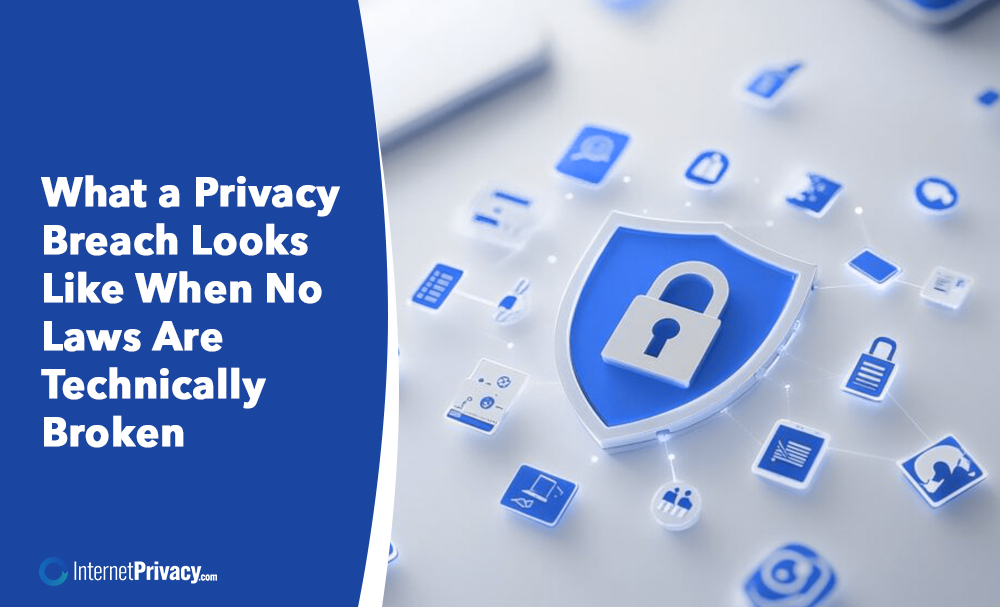What a Privacy Breach Looks Like When No Laws Are Technically Broken

Not every privacy breach makes headlines. Not every data leak results in a lawsuit. Still, even when no laws are technically broken, a privacy breach can expose sensitive data, disrupt business operations, and leave affected individuals vulnerable to fraud, identity theft, and lasting consequences.
What Is a Privacy Breach (Even Without a Law Being Broken)?
A privacy breach occurs when sensitive information, such as personal data, account details, or financial information, is exposed or mishandled in a manner that increases the risk. Human error, technical misconfigurations, or malicious actors are often the cause of this exposure.
These events don’t always trigger breach notification laws. For example:
- A spreadsheet of phone numbers and Social Security numbers gets emailed to the wrong internal team.
- A third-party vendor leaves a user account directory publicly accessible on the web.
- An employee uploads personal health information to a shared drive without encryption.
In each case, no privacy law may be directly violated. Yet personal information is exposed, trust declines, and the risk of identity theft or fraud grows.
Common Examples of Legal Grey-Area Breaches
Let’s look at what these breaches often involve:
1. Misaddressed Emails or Text Messages
Sensitive documents, such as financial information, Social Security numbers, or medical records, sometimes end up in the wrong recipient’s hands. These incidents involve no external attack. They stem from human error, but the exposed information remains real and exploitable.
2. Public Links to Private Documents
Employees may accidentally share links to folders containing personal data. If these links are publicly accessible, anyone can access the records. Still, companies may not need to notify affected individuals if there is no evidence of harm.
3. Unsecured Cloud Buckets
Files stored on cloud systems sometimes lack proper security. These unsecured folders may contain account information or corporate data. In some states, this doesn’t qualify as a breach unless consumer data is proven to have been stolen.
4. Stolen Credentials Used Internally
Hackers can use stolen credentials to gain unauthorized access to protected systems. However, because the access appears to be authenticated, it may not meet the legal threshold for a data breach under state law.
Why These Breaches Still Matter
Even without legal fallout, these incidents carry real consequences:
- Reputation Damage: Consumers lose trust, even if no formal breach occurred.
- Financial Risk: Exposed financial accounts and credit file information may lead to identity theft or the creation of fraudulent new accounts.
- Dark Web Exposure: Data from these events often ends up on the dark web, where it gets sold for financial gain.
- Lost Business: Companies risk losing clients or contracts—even when regulators don’t intervene.
- High Risk for Consumers: People affected often don’t receive alerts or free credit monitoring if the incident doesn’t meet breach thresholds.
What Are the Risks to Consumers?
For consumers, these low-profile breaches bring real danger—often without warning.
Key risks include:
- Identity Theft: Leaked Social Security numbers and financial data allow identity thieves to open new accounts or file false tax returns.
- Fraudulent Charges: Unauthorized transactions appear on credit reports or bank statements.
- Phishing Scams: Criminals use breached data to conduct social engineering via text messages, calls, or emails.
- Delayed Alerts: Without formal breach notifications, affected customers may not take action in time.
What Are the Risks to Businesses?
Even minor data leaks can spiral into serious problems:
- Operational Disruption: Companies may need to shut down systems to review and secure data.
- Loss of Customer Trust: A lack of transparency hurts brand credibility.
- Compliance Concerns: Regulatory bodies might investigate, even if no clear privacy regulations were broken.
- Vendor Scrutiny: If third-party software or systems caused the breach, parent companies or government agencies may request audits or changes.
Organizations may also face class-action lawsuits—even in the absence of fines.
How Can You Protect Yourself or Your Business?
Whether you’re a consumer or a company, several steps can reduce the likelihood and impact of a breach.
For Consumers:
- Check Your Credit File: Use major credit bureaus to monitor your credit activity.
- Freeze Your Credit: A freeze prevents others from opening new accounts in your name.
- Set a Fraud Alert: Tell credit bureaus to notify you about unusual access attempts.
- Use Credit Monitoring Tools: Sign up for free credit monitoring, especially if you have been affected by several data breaches.
- Be Wary of Phishing Scams: Avoid clicking suspicious links in texts or emails.
For Organizations:
- Train Employees: Most security breaches begin with human error. Training prevents many of these.
- Review Vendor Security: Make sure partners follow strong data security practices.
- Encrypt Sensitive Data: Always secure personal details and financial information.
- Create a Breach Response Plan: Include reporting timelines and communication steps—even if a notification isn’t legally required.
- Consult Legal Counsel: Don’t wait for a crisis. Understand your responsibilities under state laws and breach notification regulations.
Final Thought
A privacy breach doesn’t have to break the law to break trust.
Information leaked through human error, technical flaws, or third-party missteps can lead to suspicious activity, financial loss, or long-term damage. And when breach notification laws don’t apply, the responsibility falls on consumers and companies to act.
Awareness, preparation, and proactive planning remain the best forms of protection.





